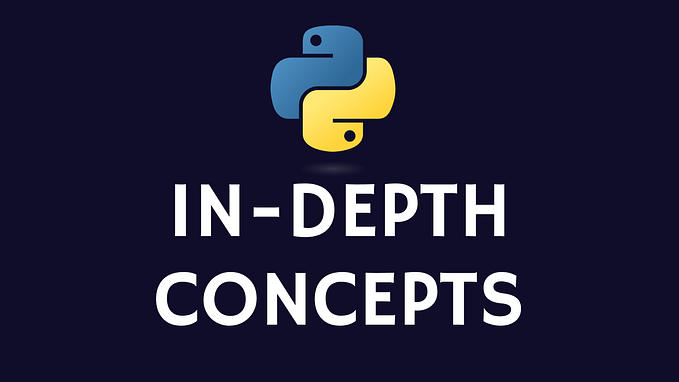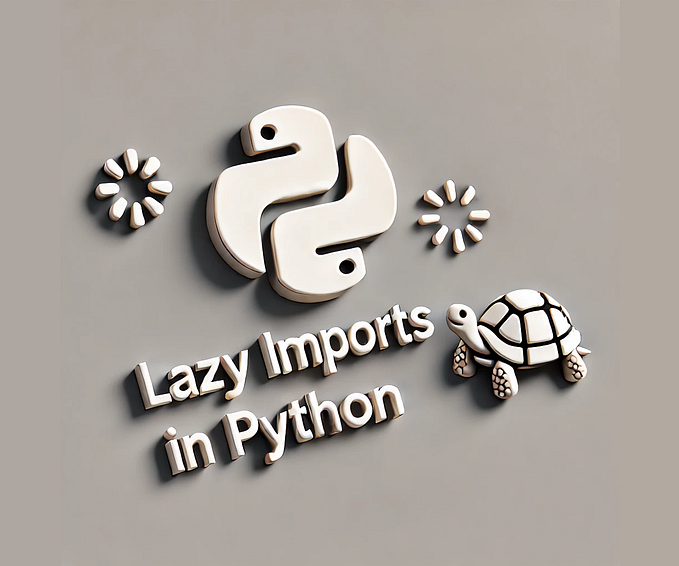Data Modeling Using Python
Three Projects That Will Level Up Your Python Game

Data modeling is an essential skill in data science and analytics.
It involves creating a conceptual framework for the data that supports the structure of a database or a data-intensive application.
Python, with its rich ecosystem of libraries, is a go-to language for data modeling.
It provides powerful tools to build, analyze, and visualize complex data structures.
This article aims to guide you through data modeling using Python by introducing three hands-on projects to enhance your understanding of data modeling concepts and sharpen your Python programming skills.
These projects will range from beginner to advanced levels and cover different aspects of data modeling, such as relational databases, NoSQL databases, and machine learning-based models.
By the end of this article, you’ll have a solid understanding of how to apply Python to real-world data modeling challenges and be well on your way to leveling up your Python skills.
What is Data Modeling?
Before diving into the projects, it’s essential to understand what data modeling entails.
Data modeling is designing a visual representation of a system’s data.
This model serves as a blueprint for creating a database or data structure that accurately reflects the relationships and constraints of the data it stores.
Types of Data Models
Conceptual Data Model:
This high-level model provides an abstract view of the data structure without getting into technical details.
It focuses on defining the entities, their attributes, and their relationships.
Logical Data Model:
A logical data model is more detailed, focusing on the specific structures within a database.
It defines the schema, including tables, columns, and data types.
Physical Data Model:
The physical data model implements the logical model in a database management system (DBMS).
It includes details like indexing, partitioning, and other database-specific optimizations.
Importance of Data Modeling
- Efficiency: Proper data modeling ensures efficient data retrieval and manipulation, reducing redundancy and improving performance.
- Accuracy: A well-structured data model minimizes the chances of data inconsistencies and inaccuracies.
- Scalability: With a solid data model, scaling your application or database becomes more manageable as your data grows.
- Collaboration: A clear data model provides a common understanding for developers, data scientists, and business stakeholders, ensuring everyone is on the same page.
Project 1: Building a Relational Database Model for an E-Commerce Platform
Overview
In this project, you will build a relational database model for an e-commerce platform.
The platform will manage products, customers, orders, and payments.
This project is suitable for beginners familiar with SQL and Python’s sqlite3 library.
Key Concepts
- Entities and Relationships: Identify the key entities (e.g., Products, Customers, Orders) and their relationships.
- Normalization: Apply normalization rules to avoid redundancy and ensure data integrity.
- SQL Queries: Write SQL queries using Python’s
sqlite3library to interact with the database.
Step-by-Step Guide
Define the Entities: Start by identifying the entities involved in the e-commerce platform. For example:
Product: Represents items for sale.Customer: Represents users who purchase products.Order: Represents a purchase made by a customer.Payment: Represents payment information for an order.
Create the Database Schema: Use Python to define the schema for each entity and their relationships. For example:
import sqlite3
# Connect to the database
conn = sqlite3.connect('ecommerce.db')
cursor = conn.cursor()
# Create tables
cursor.execute('''
CREATE TABLE Product (
product_id INTEGER PRIMARY KEY,
name TEXT NOT NULL,
price REAL NOT NULL
)
''')
cursor.execute('''
CREATE TABLE Customer (
customer_id INTEGER PRIMARY KEY,
name TEXT NOT NULL,
email TEXT UNIQUE NOT NULL
)
''')
cursor.execute('''
CREATE TABLE Order (
order_id INTEGER PRIMARY KEY,
customer_id INTEGER,
order_date TEXT NOT NULL,
FOREIGN KEY (customer_id) REFERENCES Customer(customer_id)
)
''')
cursor.execute('''
CREATE TABLE Payment (
payment_id INTEGER PRIMARY KEY,
order_id INTEGER,
amount REAL NOT NULL,
payment_date TEXT NOT NULL,
FOREIGN KEY (order_id) REFERENCES Order(order_id)
)
''')
# Commit changes and close connection
conn.commit()
conn.close()Populate the Database: Insert sample data into your database using Python.
Run SQL Queries: Write Python functions to execute SQL queries, such as retrieving all orders from a specific customer or calculating the total revenue.
Normalization: Apply normalization techniques to ensure your database is efficient and anomalies-free. For example, ensure all customer information is stored in one table, and references to customers are made using foreign keys.
Outcome
By completing this project, you’ll gain hands-on experience designing and implementing a relational database model.
You’ll also gain experience using Python to interact with databases and apply SQL for data manipulation.
Project 2: Building a NoSQL Database Model for a Social Media Platform
Overview
In this project, you will build a NoSQL database model for a social media platform.
This project will help you understand the differences between relational and NoSQL databases and how to model data for applications that require high scalability and flexibility.
Key Concepts
- Document-Oriented Databases: Understand the structure of document-oriented databases like MongoDB.
- Denormalization: Learn when and how to denormalize data in a NoSQL environment.
- CRUD Operations: Perform Create, Read, Update, and Delete (CRUD) operations using Python’s
pymongolibrary.
Step-by-Step Guide
Install MongoDB and PyMongo: First, install MongoDB and the pymongo library in Python.
pip install pymongoDefine the Data Structure: Identify the key entities and their attributes. For example, a User entity might have attributes like username, email, followers, and posts.
Create the Database and Collections: Use Python to create a MongoDB database and define collections for your entities.
from pymongo import MongoClient
# Connect to MongoDB
client = MongoClient('mongodb://localhost:27017/')
db = client['social_media']
# Create collections
users = db['users']
posts = db['posts']Insert Documents: Insert sample data into your collections.
# Insert a user
users.insert_one({
"username": "john_doe",
"email": "john@example.com",
"followers": [],
"posts": []
})Perform CRUD Operations: Write Python functions to perform CRUD operations. For example, you can create a function to add a post for a user and update the user’s list of posts.
Denormalization: Denormalization can improve performance in a NoSQL database. For instance, you might store a user’s posts within the user’s document rather than creating a separate collection.
Outcome
By completing this project, you’ll gain a basic understanding of NoSQL databases and their use cases.
You’ll also become more skilled in using Python to interact with MongoDB and model data for scalable, distributed applications.

Project 3: Building a Machine Learning Model for Predictive Analytics
Overview
In this advanced project, you will build a machine-learning model that predicts future outcomes based on historical data.
This project will help you understand how to use Python’s data modeling libraries, such as pandas, scikit-learn, and matplotlib, to create and evaluate machine learning models.
Key Concepts
- Data Preprocessing: Learn how to clean and preprocess data for machine learning.
- Feature Engineering: Understand how to select and engineer features that improve model performance.
- Model Evaluation: Learn how to evaluate machine learning models using accuracy, precision, and recall metrics.
Step-by-Step Guide
Choose a Dataset: Select a dataset for your predictive analytics model. For example, you can use the Titanicdataset to predict passenger survival based on attributes like age, gender, and ticket class.
Load and Preprocess the Data: Use pandas to load the dataset and preprocess it.
This includes handling missing values, encoding categorical variables, and scaling numerical features.
import pandas as pd
from sklearn.model_selection import train_test_split
from sklearn.preprocessing import StandardScaler
# Load the dataset
data = pd.read_csv('titanic.csv')
# Preprocess the data
data['Age'].fillna(data['Age'].mean(), inplace=True)
data['Gender'] = data['Gender'].map({'male': 0, 'female': 1})
# Split the data into training and testing sets
X = data[['Age', 'Gender', 'Pclass']]
y = data['Survived']
X_train, X_test, y_train, y_test = train_test_split(X, y, test_size=0.2)
# Scale the data
scaler = StandardScaler()
X_train = scaler.fit_transform(X_train)
X_test = scaler.transform(X_test)Build the Model: Use scikit-learn to build a machine learning model.
For example, you can use a logistic regression model for binary classification.
from sklearn.linear_model import LogisticRegression
# Initialize the model
model = LogisticRegression()
# Train the model
model.fit(X_train, y_train)
# Make predictions
y_pred = model.predict(X_test)Evaluate the Model: Use evaluation metrics to assess your model's performance.
You can use accuracy, precision, recall, and the confusion matrix to measure how well your model is performing.
from sklearn.metrics import accuracy_score, precision_score, recall_score, confusion_matrix
# Calculate accuracy
accuracy = accuracy_score(y_test, y_pred)
print(f"Accuracy: {accuracy}")
# Calculate precision and recall
precision = precision_score(y_test, y_pred)
recall = recall_score(y_test, y_pred)
print(f"Precision: {precision}")
print(f"Recall: {recall}")
# Generate a confusion matrix
conf_matrix = confusion_matrix(y_test, y_pred)
print(f"Confusion Matrix:\n{conf_matrix}")Feature Engineering: Experiment with different features and see how they impact the model’s performance.
For example, you can add new features like Fare or Embarked and retrain your model to see if performance improves.
Model Tuning: Fine-tune your model by adjusting hyperparameters.
For logistic regression, you can try different regularization strengths or solver algorithms.
Use grid search or random search to automate the tuning process.
from sklearn.model_selection import GridSearchCV
# Define hyperparameters to tune
param_grid = {
'C': [0.1, 1, 10],
'solver': ['lbfgs', 'liblinear']
}
# Perform grid search
grid_search = GridSearchCV(LogisticRegression(), param_grid, cv=5)
grid_search.fit(X_train, y_train)
# Best parameters
print(f"Best Parameters: {grid_search.best_params_}")Visualization: Use matplotlib or seaborn to visualize the model's performance.
You can plot the ROC curve, precision-recall curve, or visualize the confusion matrix to gain deeper insights into how your model is performing.
import matplotlib.pyplot as plt
from sklearn.metrics import roc_curve, auc
# Calculate ROC curve
fpr, tpr, _ = roc_curve(y_test, model.predict_proba(X_test)[:, 1])
roc_auc = auc(fpr, tpr)
# Plot ROC curve
plt.figure()
plt.plot(fpr, tpr, color='darkorange', lw=2, label=f'ROC curve (area = {roc_auc:.2f})')
plt.plot([0, 1], [0, 1], color='navy', lw=2, linestyle='--')
plt.xlim([0.0, 1.0])
plt.ylim([0.0, 1.05])
plt.xlabel('False Positive Rate')
plt.ylabel('True Positive Rate')
plt.title('Receiver Operating Characteristic')
plt.legend(loc="lower right")
plt.show()Outcome
By completing this project, you’ll gain experience building machine learning models for predictive analytics.
You’ll learn to preprocess data, engineer features, and evaluate models using Python’s powerful data science libraries.
This project will also help you understand the importance of tuning models and visualizing their performance.
Project Recap:
Relational Database Model for an E-Commerce Platform: Learn how to design and implement a relational database using Python and SQL.
NoSQL Database Model for a Social Media Platform: Understand the principles of NoSQL databases and learn how to use MongoDB for flexible and scalable data models.
Machine Learning Model for Predictive Analytics: Build and evaluate machine learning models for predictive analytics using Python’s data science libraries.
Each project is designed to challenge you and progressively improve your data modeling skills.
Data modeling is a fundamental skill for any data scientist or Python developer.
Working on the three projects outlined in this article will give you hands-on experience with different data models, including relational databases, NoSQL databases, and machine learning-based models.
Whether you are a beginner or an experienced developer, these projects will help you improve your Python skills and prepare for real-world data challenges.
Additional Resources
To further enhance your data modeling skills, consider exploring the following resources:
- Books: “Data Modeling for MongoDB” by Steve Hoberman and “Python for Data Analysis” by Wes McKinney.
- Courses: Online courses on Coursera, edX, and Udemy that focus on data modeling and Python programming.
- Communities: Join Python and data science communities on Stack Overflow, GitHub, LinkedIn, and Reddit to stay updated on the latest trends and best practices.

Applying the concepts learned in these projects and leveraging additional resources will enable you to tackle complex data modeling tasks and advance your Python development skill set.
Follow me on Medium, LinkedIn, and Facebook.
Please clap my articles if you find them useful, comment below, and subscribe to me on Medium for updates on when I post my latest articles.
Want to help support my future writing endeavors?
You can do any of the above things and/or “Buy me a cup of coffee.”
It would be greatly appreciated!
Last and most important, enjoy your Day!
Regards,







